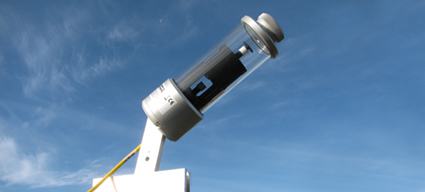Knowledge of when the sun was shining is used by various industries and sectors; including research, construction, agriculture, tourism, insurance and the legal communities. An example of insurance and legal interest is automotive accidents, which sometimes occur when the sun is shining squarely into the eyes of the driver, resulting in an inability to see properly. Knowing if the sun was shining at that particular moment can be critical if there is an insurance claim or a legal matter to be settled.
Knowing the long-term trend of how the amount of sunshine hours is increasing or decreasing is a key parameter in tracking climate change. It has been projected that the amount of cloud cover will increase and measuring the number of sunshine hours per day, season and year objectively (without the use of models) is critical to monitoring this important climate variable.
The Saskatchewan Research Council (SRC) has operated a principal Climate Reference Station (CRS) in Saskatoon, Saskatchewan since 1963 and bright sunshine has been one of twenty climate variables collected. Kipp & Zonen’s CSD 1 Sunshine Duration Sensor was put into operation in January 2001 and it compared very well to the previous bright sunshine instruments utilised at the CRS.
In 2010 and 2011, SRC expanded its Climate Reference Station network to central Saskatchewan, at the Conservation Learning Centre (CLC) near Prince Albert. A Kipp & Zonen CSD 3 Sunshine Duration Sensor was installed at the new station in the spring of 2011.
The Saskatoon Climate Reference Station began recording bright sunshine hours in 1966, and in the last 48 years has recorded some interesting variability and trends. It is possible for Saskatoon to receive up to 4490.6 hours of bright sunshine in a year, but the average was 2264 hours over the years from 1991 to 2010.
The 1990s had the lowest number of bright sunshine hours for the period of record. The lowest year was 1992, recording 43.8% of the actual to possible hours of bright sunshine. This drop was due to a downward trend during the summer season of June, July and August (JJA). Since the 1990s the trend has been towards more annual bright sunshine, increasing further between 2006 and 2012.
Due to the northern latitude, the number of sunshine hours fluctuates markedly depending on the season. The other three seasons, while variable, do not have a strong upwards or downwards trend. The summer downward trend could have been due to various reasons, including three major volcanic eruptions around the globe, plus it is projected that the amount of cloud cover will increase with climate change.
‘Bright Sunshine’ is a rather loose and subjective term, largely based upon the Campbell-Stokes glass ball and paper strip instrument, where the length of the ‘burn’ on the paper caused by the focussed image of the sun is proportional to the number of ‘bright’ hours. However, this is highly dependent upon humidity (dampness of the paper), paper type and the observer’s interpretation of ‘burnt’. The instrument requires adjustment every few days to keep the sun’s image on the paper.
The availability of objective electronic instruments without all these drawbacks, and with real-time data available remotely, prompted the World Meteorological Organisation (WMO) to propose in 1981 that a direct solar irradiance of 120 W/m2 best represented the threshold of historical ‘Sunny/Not Sunny’ measurements of hours of sunshine in a day. This was finally formalised in 2003 and defined as ‘Sunshine Duration’, with a required daily uncertainty in the number of sunshine hours of ± 10%. The Kipp & Zonen CSD 1 and CSD 3 Sunshine Duration Sensors meet this requirement.
Article by V. Wittrock, Saskatchewan Research Council, Canada

Together with our distributor, Campbell Scientific Canada Corp., Kipp & Zonen supports the Saskatchewan Research Council with the service and re-calibration of their CSD 1 and CSD 3 Sunshine Duration Sensors.
As a Campbell Scientific Canada representative explains; “SRC operates two Climate Reference Stations that serve important roles in climate monitoring; in Saskatoon, which celebrated its 50th anniversary in 2013, and at the Conservation Learning Centre near Prince Albert, launched in 2011. Each station has a Kipp & Zonen Sunshine Duration Sensor.
The CRS in Saskatoon is a key site for both the Province of Saskatchewan and the Meteorological Service of Canada climate monitoring network. The CLC station serves as the main meteorological data resource for the many crop development and demonstration programmes at the Centre and also as a learning tool in climate monitoring. It is a regular showcase for numerous school tours, research organisations, and the general public.”
Find out more about the Saskatchewan Research Council Climate Reference Stations at www.src.sk.ca/industries/environment/pages/climate-reference-stations.aspx.